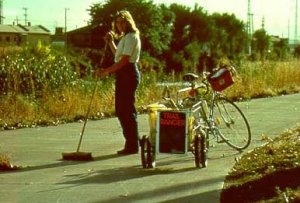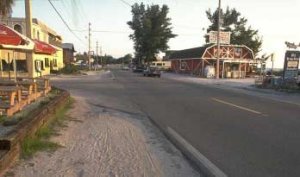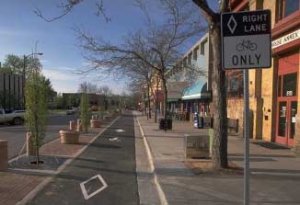U.S. Department of Transportation
Federal Highway Administration
1200 New Jersey Avenue, SE
Washington, DC 20590
202-366-4000
| < Previous | Table of Content | Next > |
 This
lesson describes maintenance programs and activities that are critical to
successful bikeways, and recommends a step-by-step approach to solving common
maintenance problems.
This
lesson describes maintenance programs and activities that are critical to
successful bikeways, and recommends a step-by-step approach to solving common
maintenance problems.
Bicycles and bicyclists tend to be particularly sensitive to maintenance problems. Most bicycles lack suspension systems and, as a result, potholes that motorists would hardly notice can cause serious problems for bicyclists. In addition, since bicyclists often ride near the right margin of the road - sometimes as required by traffic law - they use areas that are generally less well maintained than the main lanes. On higher speed roads, the passage of motor vehicle traffic tends to sweep debris to the right, where most bicyclists travel. In addition, ridges, such as those found where a new asphalt overlay does not quite cover the older roadway surface, can catch a wheel and throw a bicyclist to the ground.
Aside from these general problems, special bicycle facilities often need more maintenance than they receive. On trail systems, for example, vegetation is often allowed to overgrow the pavement edge, effectively narrowing the usable surface. And soil treatments that are commonly used under new roadbeds are sometimes ignored on trail projects; as a result, the surfaces are quickly destroyed by intruding plants.
For the most part, satisfying bicycling maintenance requirements is a matter of slightly modifying current procedures. For example, if street-sweeping crews pay a bit more attention to the right edge of the road, it can benefit bicyclists greatly.
In addition, using maintenance-friendly design and construction techniques can reduce the need for special – and sometimes costly – treatments later. For example, when paving a street bordered by unpaved alleys and driveways, paving into those alleys and driveways 10 to 20 feet (depending on grades and other features) can keep entering traffic from dragging gravel and other debris onto the paved surface.
Finally, special bicycle facilities such as bike lanes or trails may require enhanced maintenance. This cost, along with a clear understanding of who has responsibility for maintenance, should be part of every project budget.
Improving bicycle-related maintenance requires action on several fronts. First, maintenance policies used by all relevant agencies should be reviewed and changed, if necessary. Second, designers should be encouraged to "think maintenance" when they design: low-maintenance requirements should be the rule rather than the exception. And, finally, an outreach effort should be implemented to: (1) encourage bicyclists to report maintenance problems, and (2) identify existing maintenance problems, particularly on special bicycle facilities or popular bicycling routes.

Extending the paved area to include the shoulder would keep gravel
and debris off of the paved surface and prevent problems for
bicyclists.

Bike lane maintenance is particularly important.
For the most part, bicycle-related maintenance tasks involve work an agency already does; little additional effort will be required. It may simply mean adding popular bicycling routes to the priority sweeping route network, for example. In some instances, however, additional equipment may be needed. For example, maintaining a particular trail may require purchasing special equipment-perhaps a small sweeper or a special attachment for a tractor.
In regions with harsh winters, special effort should be made to clear the winter's accumulation of road sand and other debris early in the spring. Also, the periods following high winds and flooding may require special attention.
The following are some of bicyclists' most common maintenance concerns and some common solutions:
Surface problems: For potholes and other surface irregularities, patch to a high standard, paying particular attention to problems near bicyclists' typical travel alignments. Require other agencies and companies to patch to a similarly high standard; if repairs fail within a year, require remedial action.
Debris (sand, gravel, glass, auto parts, etc.) near the right edge of the road: Sweep close to the right edge. If necessary, use vacuum trucks to remove material, especially if it accumulates adjacent to curbs. Pay particular attention to locations such as underpasses, where changes in lighting conditions can blind bicyclists to surface hazards.
For debris or surface irregularities on curves or at intersections, pay special attention to the areas between the typical paths of turning and through motor vehicle traffic; often these fill with debris and are in typical bicyclist trajectories. In addition, areas where debris washes across the paved surface should receive special attention; for example, eliminating the source of the problem by providing better drainage is ultimately a more cost-effective solution than increased sweeping.
Chip seal gravel: Many local agencies use chip seal to extend the lives of their roadways. However, the technique, which involves laying down a coating of oil and a layer of crushed rock, often leaves deep piles of gravel just to the right of the typical travel paths of motor vehicles. To reduce the impact on bicyclists, remove excess gravel as soon as possible and suggest alternative routes as detours.
Ridges or cracks: These should be filled or ground down as needed to reduce the chance of a bicyclist catching a front wheel and crashing. Pay particular attention to ridges or cracks that run parallel to the direction of travel. One common location to check is where a merging lane is provided just beyond an intersection. Because traffic must merge left to continue traveling straight, the bicyclist will be crossing the joint between the merge lane and the through lane at a very shallow angle.
Encroaching vegetation: Trim back bushes and tree branches adjacent to trail edges to allow at least a 2- foot clearance between the edge of the pavement and the vegetation, paying particular attention to the insides of curves.
Grasses adjacent to trail edges: Tall grasses should be mowed regularly to expose any potential hazards that might otherwise be hidden from a cyclist's view. In addition, vegetation should be prevented from breaking up the edge of pavement and encroaching on the trail surface.
Signing and marking trails: Because they are often unique, trail signs may be subjected to frequent theft or vandalism. Regular inspections should be conducted to ensure that signs are still in place and in good condition; this is particularly true of regulatory and warning signs.
Trail markings: Generally, trails have a few simple markings (e.g., a yellow centerline); however, these should be repainted when necessary. Centerlines, for example, help encourage bicyclists to keep to their side of the trail and perform a very useful function.
On-road bicycle signs: Special bicycle signs (regulatory, warning, or information) should be maintained in the same way that other roadway signs are. Pay particular attention to bike route signs at decision points, warning signs at special hazard locations, and regulatory signs on popular bike-lane streets.
On-road bicycle markings: Bicycle lane striping should be renewed at the same time that other stripes are painted. The same goes for bike-lane pavement markings (e.g., diamond markings). Some markings may suffer from more wear-and-tear than others and deserve special attention. For instance, pavement markings that indicate the "hot spot" for traffic signal loop detectors may be in a location where car tires routinely pass; as a result, they may wear out faster than other markings.
Text and graphics for this lesson were derived from:
Federal Highway Administration, Designing for Bicycles at the Local Level, 1997.
For more information, please refer to:
AASHTO, Guide for the Development of Bicycle Facilities, 1999.
AASHTO, Maintenance Manual, 1987.
Rails to Trails Conservancy, Trails for the 21st Century, 1994.
| < Previous | Table of Content | Next > |
